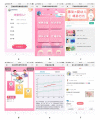Effectiveness of WeChat for Improving Exclusive Breastfeeding in Huzhu County China: Randomized Controlled Trial
- PMID: 33270026
- PMCID: PMC7746496
- DOI: 10.2196/23273
Effectiveness of WeChat for Improving Exclusive Breastfeeding in Huzhu County China: Randomized Controlled Trial
Abstract
Background: The benefits of breastfeeding for both infants and mothers have been well recognized. However, the exclusive breastfeeding rate in China is low and decreasing. Mobile technologies have rapidly developed; communication apps such as WeChat (one of the largest social networking platforms in China) are widely used and have the potential to conveniently improve health behaviors.
Objective: This study aimed to assess the effectiveness of using WeChat to improve breastfeeding practices.
Methods: This 2-arm randomized controlled trial was conducted among pregnant women from May 2019 to April 2020 in Huzhu County, Qinghai Province, China. Pregnant women were eligible to participate if they were aged 18 years or older, were 11 to 37 weeks pregnant with a singleton fetus, had no known illness that could limit breastfeeding after childbirth, used WeChat through their smartphone, and had access to the internet. A total of 344 pregnant women were recruited at baseline, with 170 in the intervention group and 174 in the control group. Women in the intervention group received breastfeeding knowledge and promotion information weekly through a WeChat official account from their third month of pregnancy to 6 months postpartum. The primary outcome of exclusive and predominant breastfeeding rate was measured 0-1 month, 2-3 months, and 4-5 months postpartum.
Results: At 0-1 month postpartum, the exclusive breastfeeding rate was significantly higher in the intervention group than that in the control group (81.1% vs 63.3%; odds ratio [OR] 2.75, 95% CI 1.58-4.78; P<.001). Similarly, mothers in the intervention group were more likely to provide predominantly breast milk (OR 2.77, 95% CI 1.55-4.96; P<.001) and less likely to give dairy products to their children (OR 0.40, 95% CI 0.21-0.75; P=.005). There was no statistically significant difference for exclusive breastfeeding rate 2-3 months (P=.09) and 4-5 months postpartum (P=.27), though more children in the intervention group were exclusively breastfed than those in the control group 2-3 months postpartum (intervention: 111/152, 73.0%; control: 96/152, 63.2%) and 4-5 months postpartum(intervention: 50/108, 46.3%; control: 46/109, 42.2%).
Conclusions: This study is the first effort to promote exclusive breastfeeding through WeChat in China, which proved to be an effective method of promoting exclusive breastfeeding in early life. WeChat health education can be used in addition to local breastfeeding promotion programs.
Trial registration: Chinese Clinical Trial Registry ChiCTR1800017364; http://www.chictr.org.cn/showproj.aspx?proj=29325.
International registered report identifier (irrid): RR2-10.1186/s12889-019-7676-2.
Keywords: WeChat; breastfeeding; exclusive breastfeeding; mHealth; randomized controlled trial.
©Qiong Wu, Yiwen Huang, Zijun Liao, Michelle Helena van Velthoven, Wei Wang, Yanfeng Zhang. Originally published in the Journal of Medical Internet Research (http://www.jmir.org), 03.12.2020.
Conflict of interest statement
Conflicts of Interest: None declared.
Figures
References
-
- Black RE, Victora CG, Walker SP, Bhutta ZA, Christian P, de Onis Mercedes, Ezzati M, Grantham-McGregor S, Katz J, Martorell R, Uauy R, Maternal Child Nutrition Study Group Maternal and child undernutrition and overweight in low-income and middle-income countries. Lancet. 2013 Aug 03;382(9890):427–451. doi: 10.1016/S0140-6736(13)60937-X. - DOI - PubMed
-
- Dewey KG, Adu-Afarwuah S. Systematic review of the efficacy and effectiveness of complementary feeding interventions in developing countries. Matern Child Nutr. 2008 Apr;4 Suppl 1:24–85. doi: 10.1111/j.1740-8709.2007.00124.x. http://europepmc.org/abstract/MED/18289157 - DOI - PMC - PubMed
-
- Stein AD, Thompson AM, Waters A. Childhood growth and chronic disease: evidence from countries undergoing the nutrition transition. Matern Child Nutr. 2005 Jul;1(3):177–84. doi: 10.1111/j.1740-8709.2005.00021.x. http://europepmc.org/abstract/MED/16881898 - DOI - PMC - PubMed
-
- Global Targets 2025. World Health Organization. [2020-04-10]. https://www.who.int/nutrition/global-target-2025/en/
-
- Global strategy for women's and children's health 2010. World Health Organization. [2020-04-10]. https://www.who.int/pmnch/topics/maternal/20100914_gswch_en.pdf.
Publication types
MeSH terms
Associated data
LinkOut - more resources
Full Text Sources
Medical
Miscellaneous



